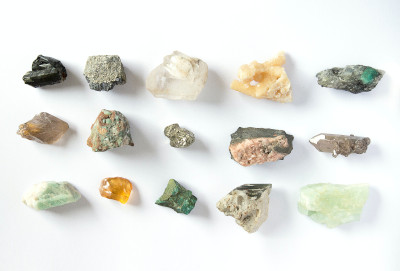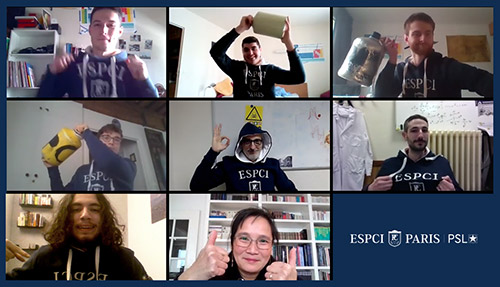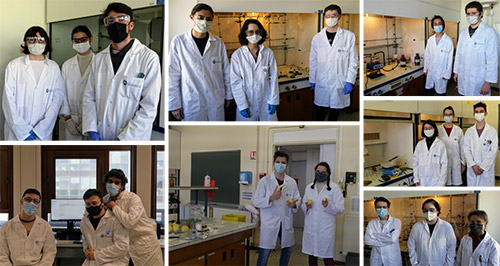Go live on Friday, March 26, 2021 at 9:45 a.m. for the 1st session of the French Chemists’ Tournament (TFChim).
What is the French Chemists' Tournament?
- It’s an opportunity to learn more about chemistry, the type of chemistry that can help protect our planet, and repair human degradation.
- It’s a chance to discover students and teacher-researchers who are passionate about chemistry and its practical applications.
- It is a moment to discover that training and research go hand in hand at ENS de Lyon: participation in the French Chemists' Tournament (TFChim) is counted within the framework of the UE L3 and Master 1 Chemistry because it teaches students to work as a team, analyze a problem and propose a model, to question experimentally a theory, meet researchers, present results and react in real-time to new ideas.
- This is an opportunity to take on a new challenge: that of a competition where 5 schools, 5 enthusiastic and motivated teams will compete in 6 scientific public debates. During these "Fights", true marathons of scientific debates, the teams take on different roles, for which students will, in turn, have to present results, criticize and debate the work of another team, or moderate a scientific debate.
The questions raised during these debates will include the following: Can we design a chocolate that doesn't melt in full sun? Is it possible to quickly and simply assess how fiery a spicy dish is, so as not to risk burning the palate? How can the brightness of indoor space be greatly increased by changing its wall covering? Will it ever be possible to admire glass windows and stained-glass windows that can continue to light up at night?
It is on these topics (and many others) that several teams of students have worked before competing, debating and exchanging ideas together on Friday, March 26, 2021 during the first French Chemists’ Tournament. Inspired by the format of IPT (International Physicists' Tournament) on a national scale, this new event will see the student teams from five major French schools compete: ESPCI Paris, école Polytechnique, ENS, Chimie Paris and ENS de Lyon.
The 2021 edition of the French Chemists’ Tournament will be sponsored by Jacques Livage, professor emeritus at the Collège de France and member of the Academy of Sciences, and Michel Verdaguer, professor emeritus at the Pierre and Marie Curie University.

Subject 1: Summary of Mendeleevites
This challenge is to offer a synthesis of a compound with as many different elements of the periodic table as possible. The compound, which can be called a "mendeleevite", must be able to be isolated, purified, and it must be possible to determine or prove its chemical structure through different methods.

Subject 2: Fire alarm
The dosage of the amount of chili in a dish is an important problem in the kitchen: the cook will want to arouse taste buds with a seasoning that is just right, so as not to “disturb” more sensitive palates.
A scale of appreciation, the Scoville scale, aims to determine the strength of the spicy peppers via the sensation caused, going from "neutral" to "explosive". Unfortunately, this scale remains quite subjective, and not quantitative.
The quest is to present a method that could enable, for example, a cook or a chef in a restaurant, to determine by chemical means (in the form of a test or a "kit" for example), and without the need to resort to complex, expensive and transportable equipment, the "spiciness" of a dish. In this challenge, you can even work on the specificity of the test that you have developed.

Subject 3: Nocturnal glow for stained-glass windows
The craft of glassmaking reached its peak in the Middle Ages during the construction of cathedrals. Throughout this spiritual period, the master glassmakers were able to use their ingenuity to awaken the grace and wonder of believers and parishioners through their creations, by using stained-glass to illuminate cathedrals.
Unfortunately, the richness of the colors depended on the intensity of the daylight - the stained-glass windows lose much of their superb effect once the sun goes down.
Therefore, the challenge is to provide, as medieval craftsmen might have done, if they had known the principles of modern chemistry, chemical systems and synthesizes to create stained-glass windows capable of lighting up cathedrals, in low ambient light or after dark. The proposed systems should be self-contained whenever possible.

Subject 4: Baudelairian fragrances
Smells, perfumes and their subtleties are recurring themes in Baudelaire's work to such an extent that it is possible to identify recurring "Baudelairian smells" that create an olfactory universe specific to his poetry, with rich nuances such as the "mixed scents of coconut oil, musk and tar" described in “La chevelure” -The head of hair. The link between meaning and writing becomes for him as "practicing a kind of evocative witchcraft. It is then that color speaks, like a deep and vibrant voice ... that perfume sets off specific thoughts and memories," he writes in his work “Romantic Art”. In this whirlwind resonating from each of the senses, the sense of smell emerges, dynamic and evolving, like a "deep, magical charm, of which we grey in the present, the restored past!" (quote from the novel “Le parfum” - The perfume).
You can suggest molecules that could be at the origin of the composition of "Baudelairian perfumes", which can change the smell reversibly as a result of a stimulus (for example, stimulation with light, a change in temperature or more generally in the surroundings, thus joining the sensory way of thinking so cherished by the poet). These molecules should not pose a health risk, when assessing their olfactory characteristics.

Subject 5: Vegetable leather
Leather is a material which is generally appreciated by many and that has been used since antiquity for its robustness and thermal resistance, is very often a valuable waste product from the meat industry. Nevertheless, it exploits animals, and its use is raising more and more questions about ethics and the environment, especially since the preparation of leather is usually high in pollutants.
Nowadays, many designers have turned to alternative leathers, entirely plant based, such as mushroom leathers (sometimes very close to velvet) or pineapple. Interest in these materials is growing.
You can suggest a technique to enhance the skins and peelings from fruit and vegetables in the form of leathers, so that they can then be used as animal leather is currently used today. The treatment process should be as compatible as possible with the principles of sustainable chemistry.

Subject 6: Hot Chocolate
The city of Lyon is often subject to significant rises in temperature, sometimes early in the year, which are likely to compromise the quality of the many tasty chocolates that can be handed out at the end of the TFChim. Chocolate is known to start melting as from 26°C.
The challenge is to suggest a method of preparing chocolate that makes it more resistance to temperatures, even if the awards ceremony takes place on a hot day or in full sun. The chocolate created must be visually and olfactorily identified in a consensual way as chocolate and must obviously be edible.

Subject 7: Get me some fresh air!
We are spending more and more time in confined atmosphere, about 80-90% of the time in a building or vehicle with the impact of an increase in the concentration of unrenewed CO2 levels in indoor spaces, and a degradation of air quality indicators, including oximetry. Increases in CO2 levels in the air, for example in a classroom, strongly affect our ability to have ideas, think deeply and learn.
You are invited to suggest a method or chemical system that can compensate for significant variations in carbon dioxide and oxygen levels in confined indoor spaces during the day, with their values being kept within a range considered optimal by scientific studies. The proposed system can be developed further by considering other indicators of air quality or domestic pollutants.

Subject 8: Fiat lux
The effects of natural light have benefits on the health and biological functions of each individual, on our internal body clock, on sleep, on our mood, on our cognitive performance, on the cardiovascular system, on the secretion of certain hormones and on our metabolism in general. The expansion of large metropolises and high urban density has led to the construction of buildings that are less and less exposed to natural light.
In this workgroup, you will propose the formulation of one or more murals that autonomously increase indoor light, and thus compensate for a lack of exposure to direct or indirect sunlight.

Subject 9: Mopping up oil spills
Oil spills are ecological and industrial disasters, consisting of an oil slick flowing into coastal areas, resulting from the often accidental, but unfortunately, sometimes voluntary, spill of crude oil or heavy fractions of hydrocarbons to the sea.
How can you deal with an oil spill? You need to come up with a chemical method that can create a clean and efficient sponge to soak up an oil slick in seawater.

École Polytechnique
Students: (from left to right) Sandrine Auffray, Marc Busicchia, Matthieu Ricard, Christophe Didier, Amaury Bregeault

ESPCI Paris-PSL
Students: Pierre-Emmanuel Bes de Berc, Lucas Dalmasso, Tom Lacoma, Gabin Lalande, Erwan Meunier
Coaches: Thomas Aubineau, Jean-Baptiste d'Espinose, Yvette Tran

Chimie ParisTech-PSL
Students: Camille Brigodiot, Lucie Cavalié, Boubacar Gandega, Louis Maratrat, Paul Saint-Amand, Yasmine Layadi
Coach: Sophie Griveau

École normale supérieure - PSL
Students: Nina Albouy, Paco Bacrie, Alexandre Chhu, Louis Escudero, Gabriel Lalou, Till Neumann, Basile Parmelli
Referees: Élise Ansart, Emma Monnier, Alice Mougey
Coach: Mathilde Lepoitevin

ENS de Lyon
Students: (from left to right) Annabelle Peyronnet, Simon Baillet, Lise Boutenegre, Théophile Lambert, Marie Lucas, Valentin Herault, Lise Boitard-Crépeau
Coaches: Belén Albela, Laurent Bonneviot, Bruno Sécordel, Vincent Wiezczny, Floris Chevallier
- 09:30-09:45 - Welcoming of participants
- 09:45-10:00 - Welcome speech
- 10:00-12:00 - “Fight 1” presentation
- 12:00-13:30 - Lunch
- 13:30-15:30 - “Fight 2” presentation
- 15:30-16:00 - Break
- 16:00-18:00 - “Fight 3” presentation
- 18:00-18.30 - Jury deliberation
- 18:30-19:00 - Announcement of results and awards ceremony
Morning snack and lunch included, all participants will receive a TFC tea-time snack and an eco-cup.

Two sponsors have kindly agreed to support the 1st edition of the tournament:
- Jacques Livage, Professor emeritus at the Collège de France and member of the French Academy of Sciences
In 1960, he obtained an engineering degree from the École nationale supérieure de chimie de Paris where he also obtained a doctorate. He was an assistant and then a master assistant at the same school from 1960 to 1973. He has been a professor at the Pierre-et-Marie Curie University since 1973 and a professor at the Collège de France since 2001.
Jacques Livage is a pioneer in the field of soft chemistry. In particular, he has developed sol-gel processes to obtain original materials that are inaccessible through the traditional channels of inorganic chemistry. His work aims in particular to copy biomineralisation processes, which are natural processes that make it possible to obtain glass-type materials under particularly mild conditions compared to conventional production processes. The industrial applications of such a chemistry are considerable.
He has published more than 500 scientific articles.

- Michel Verdaguer, Professor emeritus at the Pierre and Marie Curie University
Following a career as a secondary school teacher, assistant professor at ENS de Saint-Cloud and a thesis in the laboratory of Olivier Kahn, Michel Verdaguer became Professor at Université Pierre et Marie Curie in Paris in 1988. Michel research endeavours concentrate on molecular magnetism, in which field he has developed a rational approach to new systems, from quantum chemistry to applications, from Haldane’s gap systems – celebrated in 2016 by the Nobel Prize in Physics to F.D.M. Haldane - to room temperature magnets (Prussian blue analogues). He is presently engaged in the study of multifunctional magnetic molecular materials, at the frontiers of the tiny and of the complex. He developed the use of synchrotron radiation in molecular inorganic chemistry (EXAFS, XANES, XMCD). Emeritus Professor since 2002, he is strongly committed to developing international cooperation (Molecular Magnets Programme of the European Science Foundation, Magmanet Network of Excellence) and to lecturing worldwide on molecular magnetism with visits to Americas, Asia and Europe. He is stronly committed to citizen awareness and popularizing science for young audiences, with experiments’ presentations. He co-published book on Oxydoreduction (1991, with experiments) and (2014) a book “Electrons in Molecules” at Oxford University Press, with a revised paper back edition in 2018. An award of the Royal Spanish Chemical Society recognized the robust and tight links that he established with Spanish chemists. He holds awards from the French Chemical Society, the Royal Spanish Chemical Society and from the French Academy of Sciences.
He is a fellow of Academia Europaea.
President of the jury
Vincent Robert is a professor at the University of Strasbourg where he is currently the director of the Quantum Chemistry Laboratory.
Jury
- Cécile Rosier, Elkem
- Michel Feder, Elkem
- Laurent Garel, Solvay
- Kim Larmier, IFPEN
- Vincent Robert, Professor at the University of Strasbourg
- Stéphane Danièle, Director of the Doctoral School of Chemistry of Lyon, CPE Lyon - UCBL
- Pierre-Adrien Payard, Associate Professor, UCBL
- Stéphane Torelli, CEA Grenoble
- XX, Ecole Centrale de Lyon (awaiting reply)
- XX, INSA Lyon (awaiting reply)
- XX, CPE Lyon (awaiting reply)
- XX, Université Grenoble-Alpes (awaiting reply)
- XX, ENS Paris-Saclay (awaiting reply)
TFChim Organizing Committee
- Alexis Archambeau, Ecole Polytechnique
- Sophie Griveau, Chimie Paris Tech
- Philippe Barboux, Chimie Paris Tech
- Mathilde Lepoitevin, ENS Paris
- Yvette Tran, ESPCI Paris
- Jean-Baptiste d’Espinose, ESPCI Paris
- Belén Albela, ENS de Lyon
- Laurent Bonneviot, ENS de Lyon
Local organizing committee in Lyon
- Bruno Sécordel
- Vincent Wieczny
- Floris Chevallier
- Manon Leconte
- Marie-Chistine Giordano

Logo of the French Chemists’ Tournament
A new tournament means a new visual identity! A competition with students from the five major schools participating in the first edition of the tournament to choose the logo, which will now be the symbol of the French Tournament of Chemists (TFChim). Designed by Coline Boulanger, a chemistry student doing a double degree with the École Normale Supérieure de Lyon (ENS de Lyon) and the École Polytechnique Fédérale de Lausanne (EPFL), the logo was chosen as a bridge between the elements of the periodic classification, represented by the black insert, and the challenges of synthesis of new materials and molecules, depicted by glassware. The designer added that it is not uncommon to face many unforeseen events in chemistry, like this flickering ball, representing the challenges faced for the candidates in the tournament.







